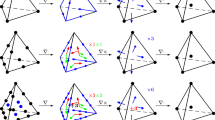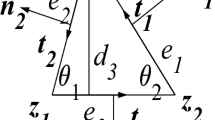Abstract
A new div FOSLS mixed finite element method is proposed and analyzed for the first-order system of the general second-order elliptic problems in terms of the scalar variable displacement and the vectorial variable flux. The main feature of the proposed method is to apply a local constant element or (bi,tri)linear element \(L^2\) projection to the div term, together with a mesh-dependent div term. The method is coercive and symmetric, allowing any combination of conforming approximations for both scalar and vectorial variables. More importantly, the method is suitable for general nonaffine quadrilateral Raviart–Thomas (RT) and nonaffine hexahedral Raviart–Thomas–Nédélec (RTN) \(H(\textrm{div})\)-elements. For nonaffine quadrilateral RT elements in two dimensions, the proposed method provides optimal approximations for the scalar and vectorial variables for the combination \(Q_m-\textbf{RT}_\ell \) for all \(m\ge 1, \ell \ge s\) where \(s=0\) corresponds to the constant element \(L^2\) projection and \(s=1\) corresponds to the bilinear element \(L^2\) projection; for nonaffine hexahedral RTN elements in three dimensions, it provides optimal approximations for the scalar variable for the combination \(Q_m-\textbf{RTN}_m\) for all \(m\ge 1\) while suboptimal approximations with order m for the vectorial variable. Numerical results are given to confirm the performance and the theoretical results of the new method.















Similar content being viewed by others
Data availability
The datasets generated during and/or analysed during the current study are available from the corresponding author on reasonable request.
References
Adams, R.A.: Sobolev Spaces. Academic Press, New York (1975)
Ambartsumyan, I., Khattatov, E., Lee, J., Yotov, I.: Higher order multipoint flux mixed finite element methods on quadrilaterals and hexahedra, M3AS. Math. Model Method Appl. Sci. 29, 1037–1077 (2019)
Arbogast, T., Correa, M.R.: Two families of H(div) mixed finite elements on quadrilaterals of minimal dimension. SIAM J. Numer. Anal. 54, 3332–3356 (2016)
Arbogast, T., Tao, Z.: Construction of H(div)-conforming mixed finite elements on cuboidal hexahedra. Numer. Math. 142, 1–32 (2019)
Arnold, D.N., Boffi, D., Falk, R.S.: Quadrilateral H(div) finite elements. SIAM J. Numer. Anal. 42, 2429–2451 (2005)
Babus̆ka, I.: Error bound for finite element method. Numer. Math. 16, 322–333 (1971)
Bendali, A.: Composite mixed finite elements on plane quadrilaterals. Numer. Methods Part. Differ. Equ. 9, 551–559 (1993)
Bernardi, C., Girault, V.: A local regularization operator for triangular and quadrilateral finite elements. SIAM J. Numer. Anal. 35, 1893–1916 (1998)
Bramble, J.H., Lazarov, R.D., Pasciak, J.E.: A least-squares approach based on a discrete minus one inner product for first order systems. Math. Comput. 66, 935–955 (1997)
Brenner, S.C., Scott, L.R.: The Mathematical Theory of Finite Element Methods. Springer, Berlin (2008)
Brezzi, F., Fortin, M.: Mixed and Hybrid Finite Element Methods. Springer, New York (1991)
Cai, Z.Q., Ku, J.: The L2 norm error estimates for the Div least-squares method. SIAM J. Numer. Anal. 44, 1721–1734 (2006)
Cai, Z.Q., Ku, J.: Optimal error estimates for the div least-squares method with data \(f\in L^2\) and application to nonlinear problems. SIAM J. Numer. Anal. 47, 4098–4111 (2010)
Cai, Z.Q., Lazarov, R.D., Manteuffel, T.A., McCormick, S.F.: First-order system least-squares for second-order partial differential equations: part I. SIAM J. Numer. Anal. 31, 1785–1799 (1994)
Cai, Z.Q., Manteuffel, T.A., McCormick, S.F.: First-order system least-squares for second-order partial differential equations: part II. SIAM J. Numer. Anal. 34, 425–454 (1997)
Cai, Z.Q., Falgout, R., Zhang, S.: Div first-order system LL* (FOSLL*) for second-order elliptic partial differential equations. SIAM J. Numer. Anal. 53, 405–420 (2015)
Chen, H., Fu, G., Li, J., Qiu, W.: First order least squares method with weakly imposed boundary condition for convection dominated diffusion problems. Comput. Math. Appl. 68, 1635–1652 (2014)
Ciarlet, P.G.: Basic error estimates for elliptic problems. In: Ciarlet, P.G., Lions, J.-L. (eds.) Handbook of Numerical Analysis, Vol. II, Finite Element Methods (part 1). North-Holland, Amsterdam (1991)
Clément, P.: Approximation by finite element functions using local regularization. RAIRO Numer. Anal. 9, 77–84 (1975)
Cockburn, B., Fu, G.: Superconvergence by M-decompositions. Part III: construction of three-dimensional finite elements. ESAIM: Math. Model. Numer. Anal., 51, 365–398 (2017)
Duan, H.Y., Liang, G.P.: Nonconforming elements in least-squares mixed finite element methods. Math. Comput. 73, 1–18 (2004)
Duan, H.Y., Liang, G.P.: Normal and tangential continuous elements for least-squares mixed finite element methods. Numer. Methods Part. Differ. Equ. 20, 609–623 (2004)
Duan, H.Y., Qiu, F.J.: A new stabilized finite element method for advection-diffusion-reaction equations. Numer. Methods Part. Differ. Equ. 32, 616–645 (2016)
Duan, H.Y., Lin, P., Saikrishnan, P., Tan, Roger C. E.: \(L^2\)-projected least-squares finite element methods for the Stokes equations. SIAM J. Numer. Anal. 44, 732–752 (2006)
Duan, H.Y., Lin, P., Saikrishnan, P., Tan, R.C.E.: A least squares finite element method for the magnetostatic problem in a multiply-connected Lipschitz domain. SIAM J. Numer. Anal. 45, 2537–2563 (2007)
Falk, R.S., Gatto, P., Monk, P.: Hexahedral H(div) and H(curl) finite elements. ESAIM Math. Model. Numer. Anal. 45, 115–143 (2011)
Girault, V., Raviart, P.A.: Finite Element Methods for Navier–Stokes Equations: Theory and Algorithms. Springer, Berlin (1986)
Jiang, B.N.: The Least-Squares Finite Element Method. Springer, Berlin (1998)
Kwak, D.Y., Pyo, H.C.: Mixed finite element methods for general quadrilateral grids. Appl. Math. Comput. 217, 6556–6565 (2011)
Li, K.T., Huang, A.X., Huang, Q.H.: Finite Element Method and Applications (in Chinese), Revised Edition, Xi’an Jiaotong University Press. Xi’an, China (1992)
Nédélec, J.C.: Mixed finite elements in \(R^3\). Numer. Math. 35, 315–341 (1980)
Nédélec, J.C.: A new family of mixed finite elements in \(R^3\). Numer. Math. 50, 57–81 (1986)
Pehlivanov, A.I., Carey, G.F., Lazarov, R.D.: Least-squares mixed finite elements for second-order elliptic problems. SIAM J. Numer. Anal. 31, 1368–1377 (1994)
Pehlivanov, A.I., Carey, G.F., Vassilevski, P.S.: Least-squares mixed finite element methods for non-selfadjoint elliptic problems: I. Error estimates. Numer. Math., 72, 501–522 (1996)
Raviart, R.A., Thomas, J.M.: A mixed finite element method for 2nd order elliptic problems. In: Galligani, I., Magenes, E. (eds.), Mathematical Aspects of Finite Element Methods, Lecture Notes in Math. 606, Springer-Verlag, New York, pp. 292-315 (1977)
Roberts, J.E., Thomas, J.-M.: Mixed and hybrid methods. In: Ciarlet, P.G., Lions, J.L. (eds.) Handbook of Numerical Analysis, vol. 2, pp. 523–639. North-Holland, Amsterdam (1991)
Sboui, A., Jaffré, J., Roberts, J.: A composite mixed finite element for hexahedral grids. SIAM J. Sci. Comput. 31, 2623–2645 (2009)
Thomas, J.M.: Sur l’analyse numerique des methodes d’elements nis hybrides et mixtes, Ph.D. Thesis, Université Pierre et Marie Curie, Paris, France (1977)
Wang, J., Mathew, T.: Mixed finite element methods over quadrilaterals. In: Dimov, J.T., Sendov, B., Vassilevski, P. (eds.) Proceedings of 3rd International Conference on Advances in Numerical Methods and Applications, pp. 203–214. World Scientific, River Edge, NJ (1994)
Yang, D.: Analysis of least-squares mixed finite element methods for nonlinear nonstationary convection-diffusion problems. Math. Comput. 69, 929–963 (2000)
Funding
This work was supported by National Natural Science Foundation of China (11971366, 11571266 and 11661161017 ) and by the Hubei Key Laboratory of Computational Science, Wuhan University, China (2019CFA007).
Author information
Authors and Affiliations
Contributions
All authors contributed to the study conception and design. All authors read and approved the final manuscript.
Corresponding author
Ethics declarations
Competing interests
The authors have no relevant financial or non-financial interests to disclose.
Additional information
Publisher's Note
Springer Nature remains neutral with regard to jurisdictional claims in published maps and institutional affiliations.
Rights and permissions
Springer Nature or its licensor (e.g. a society or other partner) holds exclusive rights to this article under a publishing agreement with the author(s) or other rightsholder(s); author self-archiving of the accepted manuscript version of this article is solely governed by the terms of such publishing agreement and applicable law.
About this article
Cite this article
Duan, H., Wang, C. & Du, Z. A Div FOSLS Method Suitable for Quadrilateral RT and Hexahedral RTN \(H(\textrm{div})\)-elements. J Sci Comput 93, 85 (2022). https://doi.org/10.1007/s10915-022-02043-y
Received:
Revised:
Accepted:
Published:
DOI: https://doi.org/10.1007/s10915-022-02043-y
Keywords
- Div FOSLS method
- Second-order elliptic problem
- Div-conforming element
- Quadrilateral RT element
- Hexahedral RTN element
- Error estimates




